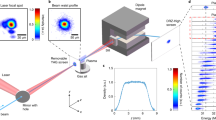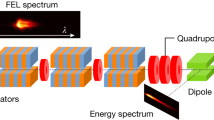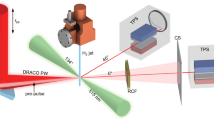Abstract
Particle accelerators are used in a wide variety of fields, ranging from medicine and biology to high-energy physics. The accelerating fields in conventional accelerators are limited to a few tens of MeV m-1, owing to material breakdown at the walls of the structure. Thus, the production of energetic particle beams currently requires large-scale accelerators and expensive infrastructures. Laser–plasma accelerators1 have been proposed as a next generation of compact accelerators because of the huge electric fields they can sustain2,3,4,5 (>100 GeV m-1). However, it has been difficult to use them efficiently for applications because they have produced poor-quality particle beams with large energy spreads2,3,4,5,6,7,8,9,10, owing to a randomization of electrons in phase space. Here we demonstrate that this randomization can be suppressed and that the quality of the electron beams can be dramatically enhanced. Within a length of 3 mm, the laser drives a plasma bubble11 that traps and accelerates plasma electrons. The resulting electron beam is extremely collimated and quasi-monoenergetic, with a high charge of 0.5 nC at 170 MeV.
This is a preview of subscription content, access via your institution
Access options
Subscribe to this journal
Receive 51 print issues and online access
$199.00 per year
only $3.90 per issue
Buy this article
- Purchase on Springer Link
- Instant access to full article PDF
Prices may be subject to local taxes which are calculated during checkout




Similar content being viewed by others
References
Tajima, T. & Dawson, J. M. Laser electron accelerator. Phys. Rev. Lett. 43, 267–270 (1979)
Modena, A. et al. Electron acceleration from the breaking of relativistic plasma waves. Nature 337, 606–608 (1995)
Umstadter, D., Chen, S.-Y., Maksimchuk, A., Mourou, G. & Wagner, R. Nonlinear optics in relativistic plasmas and laser wake field acceleration of electrons. Science 273, 472–475 (1996)
Moore, C. I. et al. Electron trapping in self-modulated laser wakefields by Raman backscatter. Phys. Rev. Lett. 79, 3909–3912 (1997)
Malka, V. et al. Electron acceleration by a wake field forced by an intense ultrashort laser pulse. Science 298, 1596–1600 (2002)
Gahn, C. et al. Multi-MeV electron beam generation by direct laser acceleration in high-density plasma channels. Phys. Rev. Lett. 83, 4772–4775 (1999)
Malka, V. et al. Characterization of electron beams produced by ultrashort (30 fs) laser pulses. Phys. Plasmas 8, 2605–2608 (2001)
Kitagawa, Y. et al. Beat-wave excitation of plasma wave and observation of accelerated electrons. Phys. Rev. Lett. 68, 48–51 (1992)
Everett, M. et al. Trapped electron acceleration by a laser-driven relativistic plasma wave. Nature 368, 527–529 (1994)
Amiranoff, F. et al. Observation of laser wakefield acceleration of electrons. Phys. Rev. Lett. 81, 995–998 (1998)
Pukhov, A. & Meyer-ter-Vehn, J. Laser wake field acceleration: the highly non-linear broken-wave regime. Appl. Phys. B 74, 355–361 (2002)
Clayton, C. E., Joshi, C., Darrow, C. & Umstadter, D. Relativistic plasma-wave excitation by collinear optical mixing. Phys. Rev. Lett. 54, 2343–2346 (1985)
Amiranoff, F. et al. Observation of modulational instability in Nd-laser beat-wave experiments. Phys. Rev. Lett. 68, 3710–3713 (1992)
Andreev, N. E., Gorbunov, L. M., Kirsanov, V. I., Pogosova, A. A. & Ramazashvili, R. R. Resonant excitation of wakefields by a laser pulse in a plasma. JETP Lett. 55, 571–574 (1992)
Sprangle, P., Esarey, E., Krall, J. & Joyce, G. Propagation and guiding of intense laser pulses in plasmas. Phys. Rev. Lett. 69, 2200–2203 (1992)
Antonsen, T. M. & Mora, P. Self-focusing and Raman scattering of laser pulses in tenuous plasmas. Phys. Rev. Lett. 69, 2204–2207 (1992)
Leemans, W. P. et al. Electron-yield enhancement in a laser-wakefield accelerator driven by asymmetric laser pulses. Phys. Rev. Lett. 89, 174802 (2002)
Pukhov, A., Sheng, Z.-M. & Meyer-ter-Vehn, J. Particle acceleration in relativistic laser channels. Phys. Plasmas 6, 2847–2854 (1999)
Strickland, D. & Mourou, G. Compression of amplified chirped optical pulses. Opt. Commun. 56, 219–221 (1985)
Pittman, M. et al. Design and characterization of a near-diffraction-limited femtosecond 100-TW 10-Hz high-intensity laser system. Appl. Phys. B 74, 529–535 (2002)
Pukhov, A. J. Three-dimensional electromagnetic relativistic particle-in-cell code VLPL (Virtual Laser Plasma Lab). J. Plasma Phys. 61, 425–433 (1999)
Acknowledgements
We acknowledge support from the European Community Research Infrastructure Activity under the FP6 “Structuring the European Research Area” programme (CARE) and from the German Scientific Council (DFG).
Author information
Authors and Affiliations
Corresponding author
Ethics declarations
Competing interests
The authors declare that they have no competing financial interests.
Rights and permissions
About this article
Cite this article
Faure, J., Glinec, Y., Pukhov, A. et al. A laser–plasma accelerator producing monoenergetic electron beams. Nature 431, 541–544 (2004). https://doi.org/10.1038/nature02963
Received:
Accepted:
Issue Date:
DOI: https://doi.org/10.1038/nature02963
This article is cited by
-
Electro-optic 3D snapshot of a laser wakefield accelerated kilo-ampere electron bunch
Light: Science & Applications (2024)
-
Non-linear QED approach for betatron radiation in a laser wakefield accelerator
Scientific Reports (2024)
-
Shaped liquid drops generate MeV temperature electron beams with millijoule class laser
Communications Physics (2024)
-
Characterization of the Spatial Atomic Density Distribution in Gas Jets from Three Different Nozzles
Russian Physics Journal (2024)
-
Enhanced laser wakefield by beating of two co-propagating Gaussian laser pulses
Journal of Optics (2024)
Comments
By submitting a comment you agree to abide by our Terms and Community Guidelines. If you find something abusive or that does not comply with our terms or guidelines please flag it as inappropriate.



